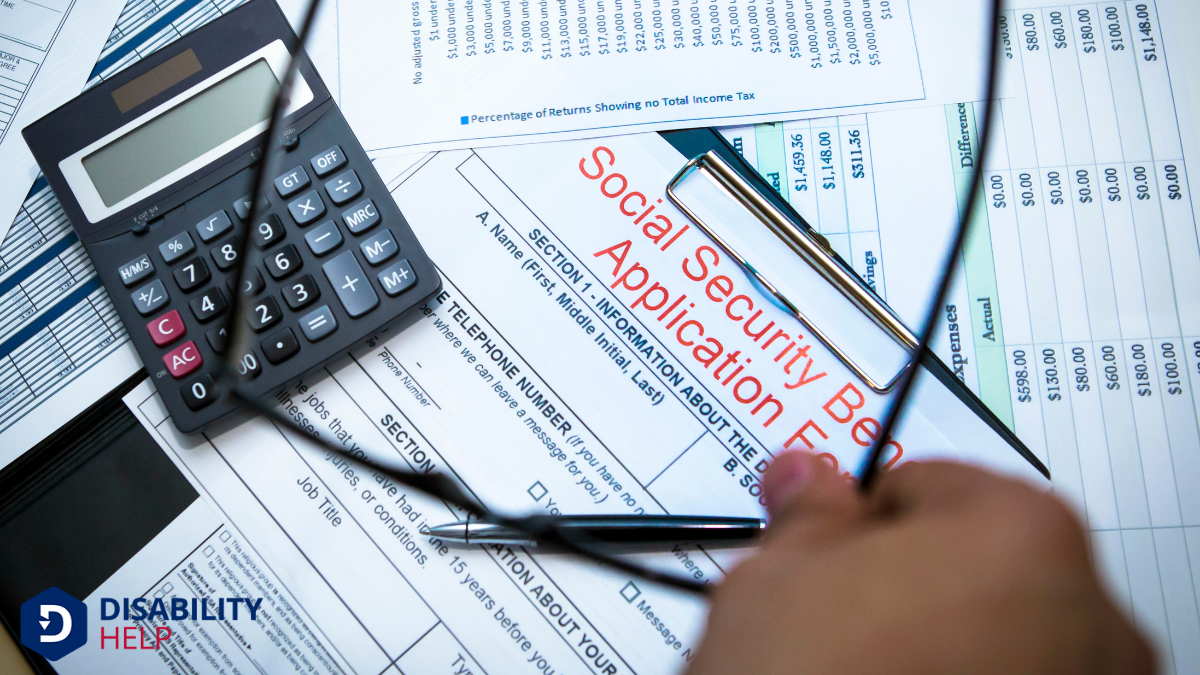You're likely wondering about the maximum monthly benefit you can receive from Social Security Disability InsuranceA form of insurance that provides income to individuals who are unable to work due to a disability. (SSDI). As of 2023, it's set at $3,627. But don't get too fixated on that number just yet. The actual amount you might qualify for hinges on various factors, including your work history and earnings. Curious to see how these elements come into play and what strategies could boost your benefits?
Key Takeaways
- The maximum monthly SSDI benefit in 2023 is $3,627.
- Benefits depend on lifetime earnings and the Primary Insurance Amount (PIA).
- Higher average indexed monthly earnings (AIME) lead to higher benefits.
- Cost-of-living adjustments (COLAs) can increase the monthly benefit amount.
- Accurate work and earnings documentation maximizes the potential benefit received.
Understanding SSDI Eligibility Criteria
Before diving into the benefits of Social Security Disability Insurance (SSDI)A U.S. government program that provides financial assistance to individuals who are unable to work d..., it's essential to understand the eligibility criteria that determine if you qualify for this support.
First, you need to have a medical condition that meets the Social Security Administration's (SSA) definition of disability, meaning it notably limits your ability to work. Your condition must be expected to last at least one year or result in death.
Additionally, you must have worked in jobs covered by Social Security and earned enough work credits. Typically, you need 40 credits, with 20 earned in the last decade. However, younger workers may qualify with fewer credits.
Understanding these requirements guarantees you know if you can access SSDI benefits when needed.
How Social Security Disability Benefits Are Calculated

Calculating Social Security Disability benefitsFinancial assistance provided to individuals who are unable to work due to a disability, such as Soc... might seem complex, but understanding the basics can simplify the process. Your benefits are primarily based on your average lifetime earnings before your disability began.
The Social Security Administration (SSA) uses a formula called the Average Indexed Monthly Earnings (AIME) to determine your benefits. They index your earnings to account for changes in general wage levels over the years.
Once your AIME is calculated, the SSA applies a formula to find your Primary Insurance Amount (PIA), which is the base figure for your monthly benefit. The PIA formula consists of specific bend points, which are percentages applied at different income levels.
Understanding this can help you estimate the financial support you might receive under the SSDI program.
The Role of Work Credits in Determining Benefits
To understand how your Social Security Disability benefits are calculated, you need to know about work credits.
You earn these credits based on your yearly income, and they play a vital role in determining your benefit amount.
Earning Work Credits Explained
Understanding how work credits affect your Social Security Disability benefits is vital. Work credits are the building blocks of your eligibility for these benefits. You earn credits by working and paying Social Security taxes.
In 2023, one credit is earned for every $1,640 of wages or self-employment income, up to a maximum of four credits per year. The total number of credits you need depends on your age and when you became disabled. Typically, you need 40 credits, with 20 earned in the last 10 years, but younger workers may qualify with fewer.
It's important to track your earnings and credits over time to guarantee you meet the requirements. Knowing this helps you plan effectively for potential disability benefits.
Impact on Benefit Calculation
When you’re figuring out your Social Security Disability benefits, the number of work credits you’ve accumulated plays an essential role.
These work credits are gained through your employment history, and they determine your eligibility and the amount you can receive. You earn work credits based on your income, and the Social Security Administration updates the earnings required for a credit annually.
To qualify for benefits, you generally need to have earned a certain number of credits within a specific time frame before your disability. The more credits and higher earnings you have, the better your potential benefits.
Average Indexed Monthly Earnings (AIME) Explained
The cornerstone of calculating Social Security Disability benefits lies in the Average Indexed Monthly Earnings (AIME). AIME reflects your lifetime earnings, adjusted for inflation, to determine your benefit amount.
To calculate AIME, first identify the years you earned the most, usually your highest 35 years. Then, adjust each year's earnings for inflation, ensuring they match current economic conditions.
Total these adjusted earnings and divide by the number of months in those years. This results in your AIME. Understanding AIME helps you grasp how your work history and earnings affect your benefits.
It’s essential to remember that AIME is just one step in determining your Social Security Disability benefits, making it important to understand your financial history accurately.
Primary Insurance Amount (PIA) and Its Importance

Understanding your Primary Insurance Amount (PIA) is essential because it determines the monthly Social Security disability benefits you can receive.
The PIA is calculated based on your Average Indexed Monthly Earnings (AIME), and several factors, such as cost-of-living adjustments, can impact it.
Calculating Primary Insurance Amount
To determine your Social Security Disability benefits, calculating the Primary Insurance Amount (PIA) is crucial, as it forms the basis of how much you'll receive monthly.
The PIA calculation involves several key steps that you should understand:
- Average Indexed Monthly Earnings (AIME): First, calculate your AIME by averaging your highest-earning years. This reflects your lifetime earnings, adjusted for changes in wage levels.
- Bend Points: Next, apply bend points to your AIME. These are specific dollar amounts established by law, which change annually. They determine how your AIME is translated into your PIA.
- PIA Calculation: Finally, use a formula involving these bend points to calculate your PIA. This formula guarantees your benefits reflect your earnings history accurately.
Understanding these steps helps demystify your benefits calculation.
Impact on Benefit Amount
Having grasped the process of calculating your Primary Insurance Amount (PIA), you can now see its direct impact on your monthly Social Security Disability benefits.
Your PIA determines the baseline for how much you'll receive in benefits. Fundamentally, it's a calculated figure based on your lifetime earnings, adjusted for inflation. The higher your average earnings, the higher your PIA, which in turn means higher disability benefits.
This amount serves as a foundation, ensuring that your benefits reflect your work history and contributions. Understanding your PIA helps you anticipate your financial situation better when relying on Social Security Disability.
It's vital since it directly influences your financial stability during times when you're unable to work due to a disability.
Factors Affecting PIA
While steering through the intricacies of Social Security Disability benefits, you'll find that several factors can greatly impact your Primary Insurance Amount (PIA). Understanding these factors is essential, as your PIA directly influences the monthly benefits you receive.
Here are the key elements:
- Lifetime Earnings: Your PIA is primarily determined by your average indexed monthly earnings (AIME) over your most productive years. Higher lifetime earnings typically result in a higher PIA.
- Age at Disability: The age at which you become disabled can affect your PIA. Generally, the earlier you qualify for disability, the sooner your PIA is calculated.
- Cost-of-Living Adjustments (COLA): Your PIA may increase over time due to annual cost-of-living adjustments, ensuring your benefits keep pace with inflation.
Factors That Influence the Maximum Benefit Amount
Several key factors can considerably influence the maximum benefit amount you receive from Social Security Disability.
First, your earnings history plays an essential role. The more you've earned and paid into Social Security, the higher your potential benefits.
Your age at the time you become disabled also matters—generally, the earlier in your working years you become disabled, the lower your benefits might be.
Additionally, the Social Security Administration uses a formula based on your average indexed monthly earnings (AIME) to calculate your benefits, which can impact the final amount.
Finally, any cost-of-living adjustments (COLAs) implemented by Social Security affect yearly benefits, potentially increasing them.
Understanding these factors helps you anticipate your benefits and plan accordingly for your financial future.
Strategies to Maximize Your Disability Benefits
When you're looking to maximize your Social Security Disability benefits, a proactive approach can make a significant difference.
First, confirm you have accurate and complete documentation. Gather medical records, employment history, and any evidence supporting your claim.
Second, understand the impact of your work history. Your benefits are calculated based on your lifetime earnings, so it’s essential to verify your work record for any discrepancies.
Third, consider consulting a disability attorney or advocate. They can help you navigate the claims process, making certain that you’ve presented the strongest case possible.
Additional Resources and Support for SSDI Applicants

As you navigate the Social Security Disability Insurance (SSDI) application process, tapping into additional resources and support can be invaluable.
Start by contacting local Social Security offices, where staff can clarify procedures and answer questions. Don’t hesitate to seek assistance from non-profit organizations specializing in disability advocacyEfforts and services aimed at protecting and promoting the rights and interests of individuals with ..., such as the National Organization of Social Security Claimants' Representatives. They can offer guidance and representationThe way people with disabilities are depicted in media, culture, and politics, often influencing pub... if needed.
Online forums and support groups provide a community of others who’ve been through the process and can share tips. Additionally, consider consulting with a disability attorney who can verify your application is accurate and complete.
Conclusion
To maximize your Social Security Disability benefits, it’s essential to understand how your work history and earnings influence your AIME and PIA. By ensuring you’ve accumulated enough work credits and comprehending the calculation process, you can better estimate your potential benefits. Remember, most people won’t receive the maximum $3,627, but being informed helps you make strategic decisions. Explore additional resources and seek support to navigate the SSDI system effectively and optimize your benefits.






